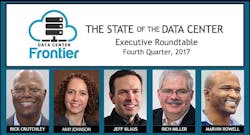Executive Roundtable: Supply, Demand & Risk Amid the Cloud Boom
Welcome to our eighth Data Center Executive Roundtable, a quarterly feature showcasing the insights of thought leaders on the state of the data center industry, and where it is headed. In our Third Quarter 2017 roundtable, we will examine four topics: How to eliminate data center downtime like the recent outage at British Airways, how the industry is being affected by robust M&A activity, opportunities for innovation in electrical infrastructure, and how the data center industry can adapt to an increasingly multi-cloud world.
Here’s a look at our distinguished panel:
- Rick Crutchley, Chief Operating Officer of IO, an innovation-driven colocation and data center services provider.
- Marvin Rowell, VP of Global Support and Service at BASELAYER, a pioneer in factory-built data center capacity that can be deployed anywhere.
- Amy Johnson, vice president of marketing and strategy for Americas at Vertiv, a global leader in designing, building and servicing critical infrastructure.
- Jeff Klaus,, General Manager of General Manager of Intel Data Center Software Solutions, that provides real-time data on power and thermal conditions for across a wide range of data center equipment.
The conversation is moderated by Rich Miller, the founder and editor of Data Center Frontier. Each day this week we will present a Q&A with these executives on one of our key topics. We begin our discussion by asking our panel.
Data Center Frontier: The data center industry has become disciplined in its construction and deployment of capital. In the past year, we’ve seen growing interest from capital providers eager to invest in the sector, while cloud providers are seeking larger and faster builds. What’s your take on how the industry is managing supply, demand and risk?
MARVIN ROWELL, BASELAYER
Marvin Rowell: The past year saw major activity in terms of new data center builds and M&A. From the finance side, colocation data centers offer investors an asset type with better cash flow and more liquidity. From the webscale side, end users leverage colocation data centers to quickly add capacity to keep pace in the ongoing cloud arms race.
With this intersection of available capital and high demand, efficient market concepts should drive colocation providers to better capacity and resourcing models. Aside from a select few providers, our observation is that this has not yet happened to the industry as a whole; there are still many opportunities to apply analytics, almost in a ‘Moneyball’ fashion, towards optimizing supply, demand and risk.
Also, as edge demand grows, an inability to utilize data to systematically provision resources will only make the inefficiencies more pronounced and costly for data center providers. Those who have the tools to analyze telemetry across infrastructure, IT, and operations will find themselves in front of the pack.
RICK CRUTCHLEY of IO.
Rick Crutchley: The public markets, institutional investors, and lenders have all become increasingly comfortable with data centers as an asset class, providing operators with access to more capital at a lower cost.
We expect this trend to accelerate as the large cloud companies continue to absorb capacity at a record pace. At this point, capital providers are essentially underwriting the credit of these giant cloud companies.
These companies demand best-in-class data center operators, with a proven development track record and operational excellence, making it harder for new market entrants.
AMY JOHNSON, Vertiv
Amy Johnson: Several years ago, there were relatively well-defined lines between market segments, with each provider driving equipment specifications based on their unique requirements. Today those lines are blurring as providers look for ease of deployment, speed to market, and capacity management, and end users look for new alternatives to meet their increasingly diverse needs. Those are among the many reasons we’ve seen such rapid cloud and colocation growth. Third-party IT providers are the answer to the supply and demand question.
Risk is more interesting. Risk, in terms of both business continuity and data security, remains a real concern and is a primary reason that some companies are maintaining their own data centers. As cloud and colo become more accepted and establish a track record of high-level data security and availability, it stands to reason that companies will outsource more applications. Eventually, some types of companies may transition out of the data center business altogether – in effect, outsourcing their IT risk to expert providers.
As hyperscale cloud and colo facilities grow and become more virtualized, their risk tolerance grows as well. Their virtualized servers act as the primary layer of redundancy, because they can move loads around in the event of partial outages. The opposite is true at the edge, where the increasing number and criticality of edge computing sites put extreme pressure on network managers tasked with keeping everything up and running. Organizations with a large distributed network of edge facilities are ramping up their service programs.
It’s no surprise investors are flocking to the data center market. The volume of data we’re generating and collecting as a society is growing exponentially, and managing that data is a robust, growing industry all its own – as the seemingly overnight rise of cloud and colo providers has shown.
JEFF KLAUS, Intel
Jeff Klaus: Cloud is absolutely an area of interest because the growth and business opportunity has been brisk. It’s changing the work we do, the tools we use, and how we ensure reliability and security.
Innovations in cloud infrastructure services and customer adoption of microservice architectures offer a level of productivity and flexibility we haven’t had previously.
Investors who understand those trends can help them effectively employ more capital toward providing customer value (instead of infrastructure), and that’s extremely attractive.
NEXT: Instrumentation and Software in the Data Center
Keep pace with the fact-moving world of data centers and cloud computing by following us on Twitter and Facebook, connecting with me on LinkedIn, and signing up for our weekly newspaper using the form below:
About the Author







